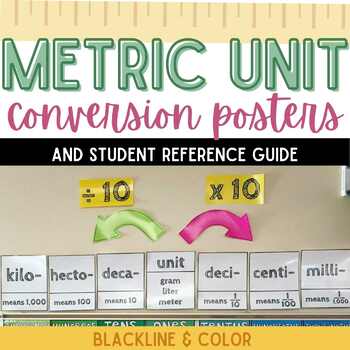Metric Unit Conversion Posters and Anchor Charts - Measurement
- PDF
What educators are saying
Description
Get your students proficient at converting metric units quickly with this visual chart of the metric system that can be posted anywhere in your classroom! They will be able to visualize the process of dividing or multiplying within the Base 10 place value system to determine metric conversion.
Visuals such as anchor charts are an instrumental scaffolding tool, and these measurement posters are perfect for your students to reference throughout the day as an important math support. Post them near your whiteboard, small group table, or wherever students can reference them most easily! These posters come in black & white or in color.
Help students make mathematical connections by placing these posters above a place value chart! Since the metric system and place value both use tens, they align very well. Please note, a place value chart is not included in this product.
Need something that students can take with them to their seats? They can also use the student "cheat sheet" anchor chart as another scaffold for referencing measurement conversion for metric and customary units. Simply print and glue to a notebook or desk!
Included in this product:
- A printable conversion chart with metric units of measurement
- Printable arrows and x10/÷10 signs as visual cues
- Color and blackline masters for printing or copying onto colored paper
- A student reference sheet ("cheat sheet") for converting customary & metric units of measurement
- American and International spelling options for the prefix "deca-"/"deka-"
This visual chart is EASY and LOW PREP to post in the classroom for maximum results!
Here's what others had to say about these anchor charts:
⭐⭐⭐⭐⭐ I loved having these on the wall because I could reference them as we were working on converting measurements and they could visually see how it followed the patterns on the place value chart below. -Michelle F.
⭐⭐⭐⭐⭐ This is one of the best resources that my students use daily! -Samantha H.
⭐⭐⭐⭐⭐ This is so great! I bought it for our metric measurement unit, and it's made it much easier to teach metric conversions!- Norma D.
⭐⭐⭐⭐⭐ I bought this in hopes to give more supports to my struggling learners and it worked! Thank you! :) - Kathryn G.
⭐⭐⭐⭐⭐ I was looking for something to add to my place value chart that incorporated fractions, and this is perfect!! -Aimee Y.
© Mrs. Dahlface 2019
Product intended for single classroom use only.
You may not redistribute, edit, sell, or post this item online, including to a class, school, or district website, without first obtaining permission from the author.





